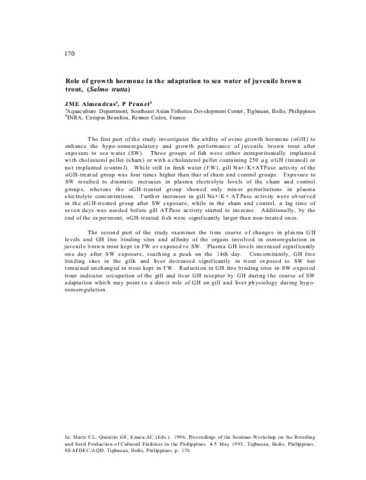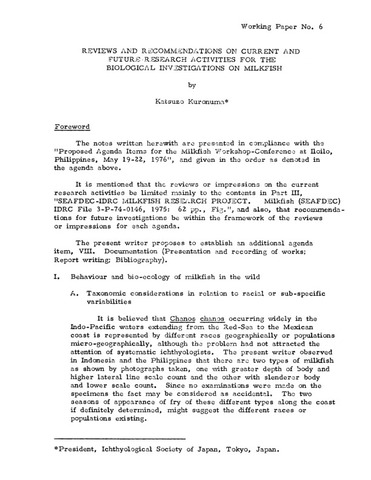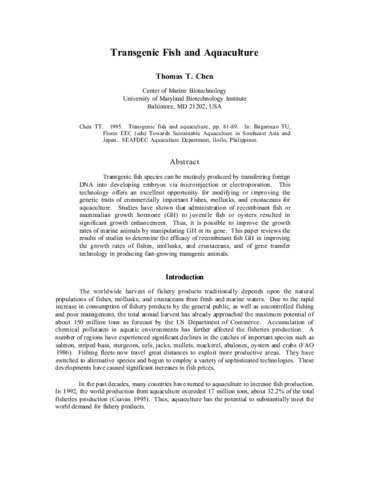| dc.contributor.author | Ayson, Felix G. | |
| dc.contributor.author | de Jesus, Evelyn Grace T. | |
| dc.contributor.author | Amemiya, Yutaka | |
| dc.contributor.author | Moriyama, Shunsuke | |
| dc.contributor.author | Hirano, Tetsuya | |
| dc.contributor.author | Kawauchi, Hiroshi | |
| dc.date.accessioned | 2013-12-19T03:52:13Z | |
| dc.date.available | 2013-12-19T03:52:13Z | |
| dc.date.issued | 2000 | |
| dc.identifier.citation | Ayson, F. G., de Jesus, E. G. T., Amemiya, Y., Moriyama, S., Hirano, T., & Kawauchi, H. (2000). Isolation, cDNA cloning, and growth promoting activity of rabbitfish (Siganus guttatus) growth hormone. General and Comparative Endocrinology, 117(2), 251-259. | en |
| dc.identifier.issn | 0016-6480 | |
| dc.identifier.uri | http://hdl.handle.net/10862/1859 | |
| dc.description.abstract | We report the isolation, cDNA cloning, and growth promoting activity of rabbitfish (Siganus guttatus; Teleostei; Perciformes; Siganidae) growth hormone (GH). Rabbitfish GH was extracted from pituitary glands under alkaline conditions, fractionated by gel filtration chromatography on Sephadex G-100, and purified by high-performance liquid chromatography. The fractions containing GH were identified by immunoblotting with bonito GH antiserum. Under nonreducing conditions, the molecular weight of rabbitfish GH is about 19 kDa as estimated by SDS–PAGE. The purified hormone was potent in promoting growth in rabbitfish fry. Weekly intraperitoneal injections of the hormone significantly accelerated growth. This was evident 3 weeks after the start of the treatment, and its effect was still significant 2 weeks after the treatment was terminated. Rabbitfish GH cDNA was cloned to determine its nucleotide sequence. Excluding the poly (A) tail, rabbitfish GH cDNA is 860 base pairs (bp) long. It contained untranslated regions of 94 and 175 bp in the 5′ and 3′ ends, respectively. It has an open reading frame of 588 bp coding for a signal peptide of 18 amino acids and a mature protein of 178 amino acid residues. Rabbitfish GH has 4 cysteine residues. On the amino acid level, rabbitfish GH shows high identity (71–74%) with GHs of other perciforms, such as tuna, sea bass, yellow tail, bonito, and tilapia, and less (47–49%) identity with salmonid and carp GHs. | en |
| dc.language.iso | en | en |
| dc.publisher | Elsevier | en |
| dc.subject | Rabbitfish | en |
| dc.subject | Siganus guttatus | en |
| dc.subject | somatotropin | en |
| dc.subject | Growth promotion | en |
| dc.subject | growth control | en |
| dc.title | Isolation, cDNA cloning, and growth promoting activity of rabbitfish (Siganus guttatus) growth hormone | en |
| dc.type | Article | en |
| dc.citation.volume | 117 | |
| dc.citation.issue | 2 | |
| dc.citation.spage | 251 | |
| dc.citation.epage | 259 | |
| dc.citation.journalTitle | General and Comparative Endocrinology | en |
| dc.subject.asfa | amino acids | en |
| dc.subject.asfa | chemical extraction | en |
| dc.subject.asfa | cloning | en |
| dc.subject.asfa | cysteine | en |
| dc.subject.asfa | DNA | en |
| dc.subject.asfa | endocrinology | en |
| dc.subject.asfa | fish physiology | en |
| dc.subject.asfa | hormones | en |
| dc.subject.asfa | marine fish | en |
| dc.subject.asfa | nucleotide sequence | en |
| dc.subject.asfa | peptides | en |
| dc.subject.asfa | pituitary gland | en |
| dc.subject.asfa | proteins | en |
| dc.identifier.doi | 10.1006/gcen.1999.7409 | |



